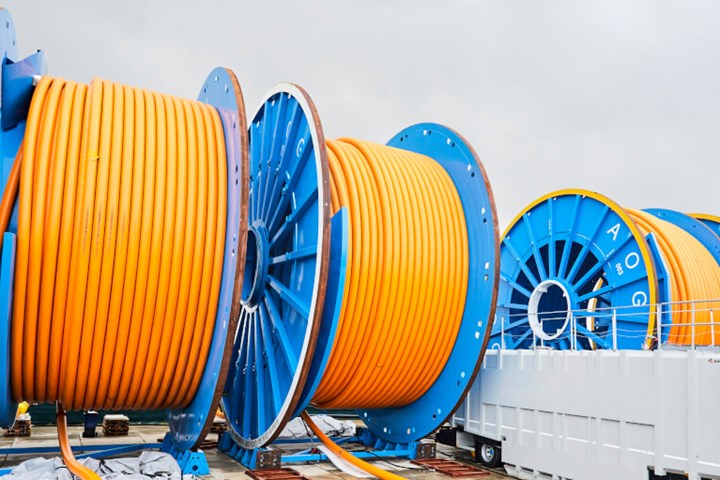Strohm thermoplastic composite pipes receive DNV certification, reported to have low carbon footprint
Strohm and Evonik’s carbon fiber/PA12 pipes are now fit to use for hydrocarbons transport. A lifecycle report also found the TCP pipes to have a 60% lower carbon footprint than an equivalent carbon steel pipeline.

Photo Credit: Strohm
Strohm (IJmuiden, Netherlands) and Evonik (Essen, Germany) have been awarded the full certification from (Høvik, Norway), attesting that the unidirectional (UD) carbon fiber PA12 tape “Vestape PA12-CF” (PA12) used for Strohm’s 100% recyclable (TCP) is fit to use for dynamic sweet and sour hydrocarbons, water and gas injection applications according to .
The two companies, in partnership with the (NLR, Amsterdam, Netherlands), have reportedly led the way in the development, qualification and supply of PA12 for TCP applications following an intensive investment and testing program over the past five years, in which the NLR provided the main composite testing facilities. The program served to develop a fundamental understanding of the material to demonstrate the lifetime performance of a product operating in a challenging chemical, thermal and mechanical environment.
During the program, Rens Ubels, principal project engineer at NLR points to one test, where the carbon fiber-reinforced PA12 specimens were tested in-situ in Norsok fluid at elevated temperatures, something that proved challenging. “We successfully designed and built dedicated fatigue and stress rupture setups to be able to meet the test specifications and the safety and health regulations,” Ubels adds.
PA12 is a fully non-metallic, corrosion-resistant solution. Reinforced with carbon fibers, it is said to be exceptionally resistant to fatigue-based failures, marking it for any dynamic application, from jumpers to flowlines and risers, including sweet and sour hydrocarbon, water and gas service. Moreover, the carbon fiber’s high stiffness, paired with the load transfer capability of PA12 as a matrix, also enables it for deepwater service and operating pressures up to 700 bar and temperatures up to 80°C. The material has been qualified for a lifetime of up to 30 years. Further expansion of the scope will include hydrogen and carbon capture use and storage.
“Developing a material class for disruptive technologies is always challenging. PA12 for Strohm’s TCP applications was no exception,” notes Carsten Schuett, industrial and energy technology leader at Evonik. “The full application of the DNV’s standard’s approach to qualify the material has only added to the complexity but, with the help of our partners, we finally succeeded in characterizing the material in unprecedented detail and unlocked its full potential. The resulting dataset can be used generically, removing the need for material qualification in further projects which further enables us to use it for energy transition applications.”
A whitepaper discussing the qualification can be found .
Eco-friendly thermoplastic pipes
DNV, Strohm and the (NIC, Cambridge, U.K.) have also launched a report comparing the lifecycle carbon footprint of externally coated carbon steel pipe and TCP, finding that the latter has a significantly lower carbon footprint — between 30-60% — than an equivalent carbon steel pipeline solution.
The report outlines the results from a joint industry project (JIP) between the three companies focusing on the lifecycle of a 22-kilometer (14-mile) pipeline transporting produced water for injection in a field outside Angola in western Africa, with an operating lifetime of 20 years.
The companies considered all steps of the lifecycle carbon footprint which is a measure of the direct and indirect greenhouse gas (GHG) emissions associated with all activities in the product's life cycle, from material extraction and production to the end-of-life (EOL) stage of the pipelines.
According to Caroline Justet, business growth executive for energy in transition at Strohm, the study takes a significant step towards establishing TCP as a suitable alternative to steel in offshore applications.
Related Content
Plant tour: Teijin Carbon America Inc., Greenwood, S.C., U.S.
In 2018, Teijin broke ground on a facility that is reportedly the largest capacity carbon fiber line currently in existence. The line has been fully functional for nearly two years and has plenty of room for expansion.
Read MoreOtto Aviation launches Phantom 3500 business jet with all-composite airframe from Leonardo
Promising 60% less fuel burn and 90% less emissions using SAF, the super-laminar flow design with windowless fuselage will be built using RTM in Florida facility with certification slated for 2030.
Read MoreCarbon fiber composite pallet revolutionizes freight industry
LOG Point Pallet fuses advanced materials with innovative design and manufacturing to improve supply chains worldwide.
Read MorePlant tour: Airbus, Illescas, Spain
Airbus’ Illescas facility, featuring highly automated composites processes for the A350 lower wing cover and one-piece Section 19 fuselage barrels, works toward production ramp-ups and next-generation aircraft.
Read MoreRead Next
Ceramic matrix composites: Faster, cheaper, higher temperature
New players proliferate, increasing CMC materials and manufacturing capacity, novel processes and automation to meet demand for higher part volumes and performance.
Read MoreScaling up, optimizing the flax fiber composite camper
Greenlander’s Sherpa RV cab, which is largely constructed from flax fiber/bio-epoxy sandwich panels, nears commercial production readiness and next-generation scale-up.
Read MoreUltrasonic welding for in-space manufacturing of CFRTP
Agile Ultrasonics and NASA trial robotic-compatible carbon fiber-reinforced thermoplastic ultrasonic welding technology for space structures.
Read More












